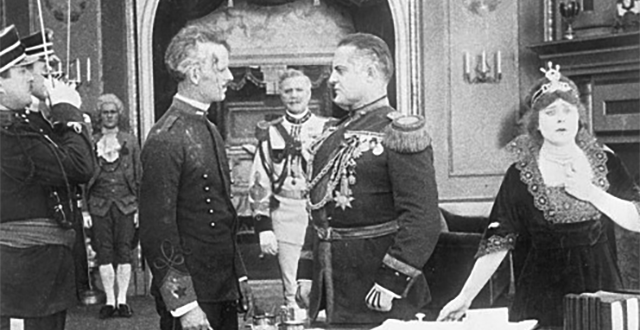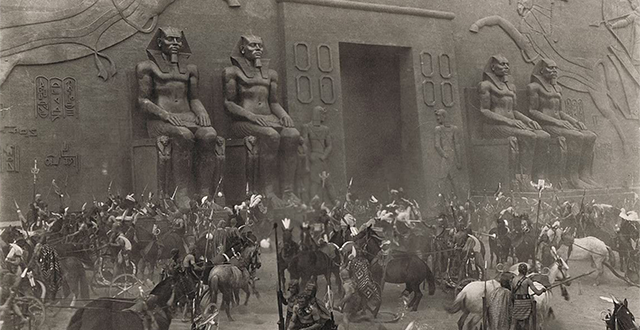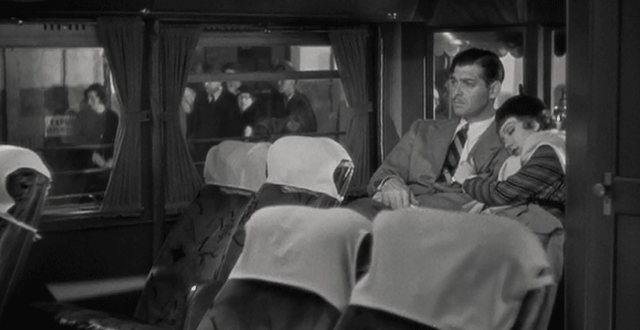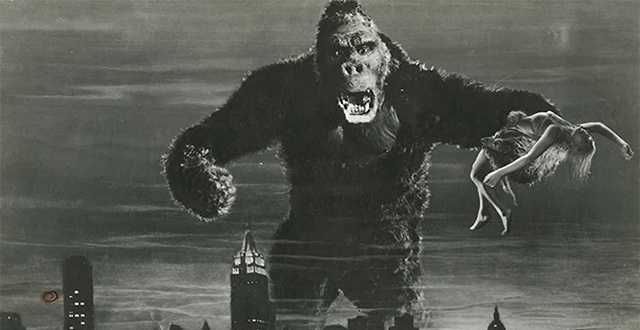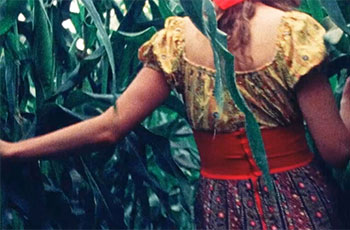News
Out of the Vaults: “Civilization”, 1916
Meher Tatna
On October 21, 1916, the La Crosse Tribune carried a full-page advertisement for the next day’s release of Thomas Ince’s epic silent movie Civilization. Under a black and white picture of a listing ship going down in a storm as a lifeboat full of people foundered nearby, the breathless headline proclaimed:
Thos. H. Ince’s $1,000,000.00 SPECTACLE
Vividly Pictures the Modern Menace of SUBMARINE WARFARE
A Masterpiece that throws a glaring light on the world’s flaunting boast of a higher progress.
Below that are the following details:
Actual Sinking of an Ocean Liner.Two Battleships Sunk by United States Navy.$18,000 Used for Ammunition in One Battle.40,000 People Employed.10,000 Horses in Thrilling Cavalry Charges.40 Aeroplanes in Great Air Battle.Every Death-dealing Device Known to Modern War in Operation.One Year in the Making.Cost $1,000,000.00.Entire Cities Built and Destroyed.An Awe-inspiring Spectacle that one minute makes your blood run cold and another thrills you with its touches of human gentleness.The Story of the Greatest Love of the Ages – the Love of Humanity.
Promising a “Prologue by Flesh and Blood Actors,” the shows were priced at 50¢, 75¢ and $1; 25¢ for bargain matinees.
The film actually only cost $100,000 according to film archivist Brian Taves in his book Thomas Ince: Hollywood's Independent Pioneer, and earned $800,000 at the box office. It opened in Los Angeles in April 1916, then was recut with additional scenes for its New York premiere later that year.
Ince, the producer of about 800 films, who was the first to build his own studio, Inceville, with an assembly line system of filmmaking, is best known nowadays as the man who met a mysterious death at age 44 aboard the Oneida, William Randolph Hearst’s yacht, on which Ince was a guest. Rumors circulated about how he was shot in the head by Hearst, though officially he was reported to have died of a heart attack. Gossip columnist Louella Parsons who had been on the yacht was supposedly paid off by Hearst with a lifetime contract to syndicate her column in his newspapers in exchange for her silence.
Ince was also a director on Civilization, along with Reginald Barker and Raymond B. West, a film which is considered one of the first anti-war films. In 1916, the US had not yet joined WWI. The Democratic National Committee claimed that this was the film that helped Woodrow Wilson regain the presidency in 1916; his slogan “He Kept Us Out of War,” inspired Ince to make the film. Wilson was shown the film before its release and a print was even sent to the Pope. Nevertheless, the US did eventually join the war in 1917, whereupon the film was yanked out of theaters.
Originally titled He Who Returned, the film is a Christian allegory written by C. Gardner Sullivan and was the first one in which an actor (George Fisher) portrays Christ, billed as “the Christus” in the opening credits. The film is set in a peaceful European country whose king Wredpryd (Herschell Mayall in full army regalia) decides to start a war to increase his power. The male populace is conscripted by force, the women start a movement called Mothers of Men, and one of the king’s courtiers, Count Ferdinand (Howard Hickman) is ordered to combat because he invented a submarine that could torpedo enemy ships. But when faced with sinking a ship carrying not only ammunition but innocent passengers, he refuses and sinks his own ship instead. His change of heart is because of the influence of the pacifist fiancée (Enid Markey) he left behind.
Gravely injured, Ferdinand is rescued but descends into some sort of purgatory where the spirit of Christ inhabits him. Once back in Wredpryd, the king – “a modern Pontius Pilate” according to the supertitle – orders his execution, but Christ emerges from the Count’s body and takes the king to the battlefields to show him the havoc he has wreaked. The king repents and peace returns to the land.
The battle scenes are quite spectacular, with three cameramen credited. Considering that cameras were immovable back then, what Ince has achieved is impressive, wrangling the ships and seas as well as the hundreds of extras in the land battle scenes. Like most silent movies, the acting is declamatory and overly theatrical, and the supertitles veer into the banal. Variety’s reviewer was moved to say, “In his effort to project pathos, he slops over into bathos.” The religious messages are unrelenting as well, but given the time and circumstances of the film’s release, it was a great success and received very good notices, some reviewers comparing it favorably to D.W. Griffith’s Birth of a Nation. It was re-released several times, the last time in 1931.
However, the Los Angeles Times reviewer ignored the pacifist message, dismissed the poster’s breathless dedication to “that vast army whose tears have girdled the universe – the Mothers of the Dead,” and wrote that the depiction of Christ was “…not daring, it is only poor taste.” He went on to damn the film further: “Realizing the vast sum of money and the huge investment of talent and good faith that have been expended in this pretentious film, it is with deep regret that I am compelled to report it as a disappointment.” He was unmoved by the interview that Fisher, the actor playing Christ, had given to his paper, explaining that he lived the life of a recluse, spending his time in study and meditation in preparation for the role. “I can say in truth that the playing of this part has affected my whole life and the impressions will never leave me,” he told the Times.
Civilization was restored by The Museum of Modern Art with funding provided by the Hollywood Foreign Press Association and The Film Foundation. The source material was a shortened version that was used as the basis from a 1931 re-issue; it was all that survived of the film.
Out of the Vaults: “The Ten Commandments”, 1923
Meher Tatna
In May 1923, Adolph Zukor, head of Paramount Pictures, sent director Cecil B. deMille a telegram: “You have lost your mind. Stop filming and return to Los Angeles at once.”
The director was in the middle of shooting his epic The Ten Commandments at the Guadalupe Nipomo Dunes in Central California. A gigantic set had been erected as Ramses’ city by 500 carpenters and 600 painters and decorators. It included a 120 foot-tall temple, five enormous sphinxes, a 100-foot Great Gate, statues of the Pharaoh, and a 750-foot long city wall which deMille insisted on as he wouldn’t work with painted backgrounds. Also constructed was the ‘City of deMille,’ the 24 square-mile tent city which held the cast, extras and crew of 2,500, along with 3,000 animals.
The director responded to Zukor: “I cannot and will not make pictures with a yardstick.” According to author Sumiko Higashi in her book “Cecil B. DeMille and American Culture: The Silent Era,” he said, “What do they want me to do? Stop now and release it as The Five Commandments?” There was, in fact, no stopping. Filming in this location took a breakneck three weeks. A Los Angeles Times article quoted deMille as telling his actors, “Your skin will be cooked raw. You will miss the comforts of home. You will be asked to endure perhaps the most unpleasant location in cinema history. I expect of you your supreme efforts.”
After the shoot wrapped, deMille was required to strike his set before departing. But the expense was too great. Rather than abandon it, and fearing rival filmmakers might use it to make cheap knockoffs, he dynamited the structures and bulldozed sand over them. (The set was discovered in 2004 and excavated piece by remaining piece in a number of attempts over several years.)
The Ten Commandments cost $1,475,836.93 and grossed $4,169,798.38 in unadjusted dollars in its initial release. It was Paramount’s highest-grossing film for 25 years until deMille himself broke that record. In his 1959 autobiography, deMille wrote, “The really important question to ask about a motion picture is not ‘What did it cost?’ but ‘What is it worth?’ The real worth of a picture cannot be measured in money alone. As soon as The Ten Commandments was completed, I screened it for Jesse Lasky and Sid Kent [Paramount sales department head]. The next day Kent wired Mr. Zukor: ‘The Ten Commandments is not a motion picture. It is bigger than all the motion pictures that have been made. It plays on the emotion in a manner that I have never felt or witnessed before and will do more good than all the combined pulpits of the country.’”
The reaction must have been a relief to deMille who was trying to salvage his reputation after a string of flops, the latest being Adam’s Rib, one of a series of light comedic films which underperformed at the Famous Players-Lasky studio where he was contracted before it became Paramount Pictures.
To find subject matter that directly appealed to the audience, deMille had sponsored a contest in the LA Times on October 9, 1922, soliciting suggestions from the public. The article was titled ‘Cecil de Mille Offer of $1,000 Can be Captured by Originator of Best Film Idea.’ Thousands responded. He chose the one submitted by F.C. Nelson, a Michigan man, that said, ‘You cannot break the Ten Commandments – they will break you.’
The film, written by Jeanie MacPherson, is devised in two parts. The Biblical Prologue is preceded by this intertitle to set up the film: “Our modern world defined God as a ‘religious complex’ and laughed at the Ten Commandments as OLD FASHIONED. Then, through the laughter, came the shattering thunder of the World War. And now a blood-drenched, bitter world – no longer laughing – cries for a way out.” Most of the intertitles in the prologue are Biblical quotes.
The prologue, which is about 45 minutes, is about Moses (played by Theodore Roberts) and Rameses’ (Charles de Roche) as they clash over the freeing of the enslaved Hebrews in Egypt where they are laboring under the cruel Pharaoh. A series of plagues, including the taking of every family’s first-born son, causes Ramses to allow the Exodus, after which he changes his mind and pursues the Hebrews in a spectacular chariot chase, only to lose them to the parting of the Red Sea. Moses then goes to the Mount to receive the ten commandments for 40 days and nights, only to return to the debaucheries of his people, worshipping a Golden Calf and participating in hedonistic displays. Prominent among them is the fetching Miriam (Estelle Taylor). Moses invokes the Wrath of God upon them, Miriam is afflicted by leprosy, the sinners are struck down by lightning, the film dissolves into the present day (1923) where part two, the Modern Story, begins.
Now the audience meets the MacTavishes – the fundamentalist zealot Martha (Edythe Chapman), and her sons John (Richard Dix) and Dan (Rod LaRoque). Both fall in love with the same woman, Mary (Leatrice Joy), but it’s Dan who wins her and they split from the family, disavowing the mother’s religion. Flash forward three years and now Dan is a successful building contractor, slowly breaking all ten commandments on the road to success, while the pious John has remained at home with the mother and continues his carpenter trade. In the melodrama that ensues, Dan is punished for his sins, but only after he builds a church with adulterated concrete, hires his brother to take the fall, watches his mother die when a wall collapses on her, shoots his mistress (Nita Naldi playing a stereotypical Asian whore), and drowns in a storm when he tries to escape on a speedboat. John and Mary are reunited and live happily ever after reading the Bible.
The Biblical Prologue was the kind of film that made deMille’s reputation as a director of spectacles. The impressive sets, thousands of extras, special effects like the parting of the Red Sea (water poured over Jell-O, then reversed through the camera in a double exposure) and use of occasional Technicolor for the Exodus scenes, provided the sensational displays the audiences craved. These Exodus scenes are pretty spectacular considering there was no CGI, all the extras moving en masse in the distance, the camera cutting to scenes in the foreground to show the scramble of families dragging their cattle and belongings with them.
deMille was the first director to hire an art director for Commandments and used a record six cameramen, one only for the Technicolor scenes. The church construction scenes in part 2 are also remarkable, particularly the one in which Mary uses an elevator to go to John on the rooftop, both their points of view recorded through tracking shots that include the surrounding city.
The film premiered in New York at the George M. Cohan Theatre on December 21, 1923, where the lobby was decorated Egyptian-style. In Hollywood, it premiered at the Grauman’s Egyptian Theatre on December 4, preceded by a stage show entitled ‘A Night in Pharaoh’s Palace.’ It got universally good notices from the critics for the Prologue; the Modern Story was not as well-received, Variety calling it “ordinary. . . hoke.”
A touring show with a 28-piece orchestra to play the Hugo Riesenfeld score lasted for months. Eleven companies toured Europe. There were 250 screenings in London alone.
deMille, who had severed ties with Paramount in 1925 over the bitterness of the budget dispute, returned to the studio in 1932. He remade The Ten Commandments as a full-length film in 1956, which is the more famous version, with Charlton Heston as Moses and Yul Brynner as Pharaoh. It was once again Paramount’s most expensive picture to date.
The Ten Commandments was restored by the George Eastman House with funding provided by the National Endowment for the Arts, The Film Foundation, the Hollywood Foreign Press Association, and the George Eastman House Preservation Fund. In 2002, The George Eastman House started work on restoring the film from deMille’s personal 35mm nitrate print. deMille kept one print of every one of his features; most of his silent films were given to the George Eastman House following his death in 1959. This was part of an ongoing initiative to restore the color back to deMille’s silent films, with tinting matched and reproduced by the Desmet process. Reel 8 of deMille’s personal copy was incomplete due to nitrate decomposition. This was replaced with material held at the Library of Congress. Tinting records were used to restore the color tints to this reel from an original screenplay held in the Cecil B. deMille Archives at Brigham Young University in Utah.
COMMEMORATING 30 YEARS OF TFF
A few days ago, as the election results were becoming clearer, movie lovers started to circulate relevant scenes and images—for instance, the dueling Inquirer headlines in Citizen Kane, “KANE ELECTED” and “FRAUD AT POLLS!” A few days earlier, when we saw the footage of the Biden campaign bus almost run off the road in Texas, some of us were reminded of another film reference: the carload of young Jeff Smith supporters sideswiped by the Taylor machine truck that brings the furious “David and Goliath” montage in Mr. Smith Goes to Washington to a stirring close.
Today, I’m thinking of a different moment from another Frank Capra movie. It Happened One Night, which The Film Foundation helped MoMA to restore, is one of Capra’s most popular and successful films and also one of his greatest. It’s a poem of the open road. It’s a romantic comedy of enlightenment in which the man and the woman learn from each other and come together on a level playing field. And it’s a film of unparalleled warmth. The interlude on the night bus, from the singing of “The Man on the Flying Trapeze” through the moment when Colbert and Gable give all their money to the starving boy and his mother, is one of the most moving passages in American cinema.
“Something that kind of disappoints me is that most of the new technology from the ’80s onwards has been about the atomization of society,” said Brian Eno in a recent Times interview. “It’s been about you being able to be more and more separate from everybody else…To be alive now is to see the possibilities of ever-increasing separateness.” The last four years have embodied some kind of culminating point in this commerce-fueled and social media-facilitated drift away from the frequently maddening but potentially creative messiness and intimacy of common life. Right now, it feels like the helium is leaking from the balloon—after all, there’s a limit to the number of ways and times you can declare your own difference. This sequence from It Happened One Night embodies a spirit directly opposed to ever-increasing separateness: human solidarity.
- Kent Jones
Follow us on Instagram, and Twitter!
IT HAPPENED ONE NIGHT (1934, d. Frank Capra)
Preserved by The Museum of Modern Art with funding provided by The Film Foundation.
Out of the Vaults: “King Kong”, 1933
Meher Tatna
In her autobiography “On the Other Hand,” Fay Wray says when director Merian C. Cooper offered her the role of Ann Darrow in King Kong opposite “the tallest, darkest leading man in Hollywood,” she thought her co-star would be Gary Cooper. Of course, he turned out to be the best-known monster in cinema history, star of the 43rd film on the AFI’s list of the 100 greatest American films ever made and listed with the National Film Registry in 1991.
The film was sold to the public with this tagline: “They said it couldn't be filmed – but it was! See it and ask – what if such a thing could happen?” Most of the posters have a giant Kong clutching a tiny Wray, sometimes with a plane in the other hand. British mystery writer Edgar Wallace’s name is also featured prominently on them – he is billed this way: “from an idea conceived by Edgar Wallace [and, in tiny type,] Merian C. Cooper.”After a four-minute overture by composer Max Steiner, the movie opens with unusual credits. On the title card, only Executive Producer David O. Selznick is named, followed by the co-directors Cooper and Ernest B. Schoedsack. Technical credits follow, given pride of place, followed by every other above-the-line talent except the cast. The cast, listed as “The Players” is next, headed by Wray, all on the same card. King Kong is listed last on his own card as “The Eighth Wonder of the World”, leaving no doubt he is the star of the film. Indeed, “The Eighth Wonder” was one of the working titles of the screenplay.
Jungle films were popular at the time, Tarzan films were the rage, and Cooper and Schoedsack had made a previous animal film in 1927 called Chang: A Drama of the Wilderness about monkeys. At Selznick’s RKO, Cooper made The Most Dangerous Game, another animal picture starring Wray, directed by Schoedsack, and then used those sets to shoot King Kong. Edgar Wallace was hired to write the script with a view to capitalizing on his name. He passed away after turning in a first draft, and a number of other writers, including Schoedsack’s wife, Ruth Rose, finished the shooting script. The budget was allocated as $500,000.
In the film, producer Carl Denham (played by Robert Armstrong) having heard of a monster that lives on an unmarked island, decides to charter a ship to go film it. Being very closemouthed about his plans, he manages to find an impoverished actress, Ann Darrow (Wray), willing to go along with his secret plans on faith. Once the ship arrives on the island, the natives capture Ann to sacrifice her to the giant ape Kong. Kong seizes her and takes her back to his lair. The crew, led by love interest Jack Driscoll (Bruce Cabot) goes to rescue her, losing many in the fight, but Kong is eventually captured and brought back to New York where he escapes and ends up on the Empire State Building with Ann, in one of the most famous scenes in cinema history.
Borrowing the stop-motion animation technology from a scrapped movie called Creation, Cooper hired that picture’s chief technician Willis O’Brien (who gets third billing in the opening credits) to create Kong. Three months of research were devoted to creating the location, fauna and indigenous people of the mythical Skull Island, and models, drawings and illustrations were made studying photos and films of gorillas. Using techniques such as rear projection and the Dunning and Williams Travelling Matte Processes allowed the directors to shoot the foreground and background separately. Previously shot footage was projected onto a cellulose acetate screen and the live-action in front of it was filmed. Wray spent many, many hours sitting in a tree and screaming at the screen. Miniature projection was another technique used in the scenes in which Wray sits in Kong’s hand. The Kong model had rubber skin and muscles built onto a steel frame, which was then covered with latex and fur. An 18-inch model was used for most of the scenes on the island.
A 20-foot head was also created, in which three technicians could sit and manipulate Kong’s ‘expressions’ with levers. A giant foot to crush his victims and a giant hand were also built separately. Wray also spent a whole day of recording screams in a sound studio which she dubbed “the aria of the agonies.”
For her scenes with Kong, Wray was put in the mechanical hand which was raised by a crane ten feet. She explained in her autobiography how those scenes were shot. “The big arm, about six feet long, was attached to a lever so it could be raised or lowered. I would stand on the floor while a grip ... would place the flexible fingers around my waist in a grip secure enough to allow me to be raised to a level in line with an elevated camera. There was a wind machine to give motion to my clothes, and I struggled to give the illusion that Kong was a fearsome forty feet tall.”
Even though the production took eight months with long stretches off for the cast as the producers worked on the special effects, Cooper and Merian shot fast, often with 20-hour filming days. The scene of the islanders’ sacrifice to Kong involving hundreds of extras, flaming torches and tens of crew, shot on a Culver City backlot, was done in one night. The wall on the island separating the village from the jungle set was repurposed from Cecil B. deMille’s 1927 King of Kings. The gate was reused from D.W. Griffith’s 1916 Intolerance.
The theater scene where Kong is displayed to the New York audience was shot at the Shrine Auditorium in downtown Los Angeles, and the Empire State Building’s spire was replicated at the RKO lot for the final scene, using plane models that “shot” at Kong, and then cutting in footage of actual planes. Kong’s roars were lion and tiger roars recorded at a zoo and then played backward in slow motion. The film went $270,000 over budget. Wray made $10,000 for ten weeks’ work.
Cooper paid Max Steiner $50,000 out of his own pocket to compose an original score for the film with a 46-piece orchestra, one of the first films to do so. Till then, movies used background music for scores. The score was recorded on three tracks for sound effects, music and dialogue. Steiner would go on to a successful career writing scores for movies such as Casablanca (1942) and Now, Voyager (1942). His use in the score of themes for characters in the films was also innovative.
The picture opened at Radio City Music Hall and the Roxy Theater in New York City simultaneously, and 50,000 people saw it on the first day. There were ten shows daily. In Los Angeles, it premiered at Grauman’s Chinese Theater with the Kong head displayed in the lobby. King Kong saved RKO which had gone into receivership on the day of its New York premiere. That weekend’s grosses alone, just in NYC, were $90,000, and RKO earned $1,761,000 in its initial year of release. A sequel, The Son of Kong, was released that same year.
King Kong is a pre-Code movie, released in 1933 one year before the restrictions of the Hays Code went into effect. For subsequent releases of the film, starting with the one in 1938, several scenes were censored. One was when Kong peels off Ann’s clothes, another was when he bites off a woman’s head and stomps a villager into the ground, and yet another was grabbing a woman from a hotel room and throwing her when he realizes she’s not Ann. Another was a scene where men thrown down a ravine by Kong were eaten by giant spiders. (Most of these edits were eventually restored in 1971 except for the last one. We know that one existed from photographs.) The film was even colorized in 1988.
The film was restored in collaboration with Warner Bros. with additional funding provided by the Hollywood Foreign Press Association and The Film Foundation. WB had the surviving elements on hand – a dupe negative from an RKO studio print. The print was scanned at 4K resolution on a Northlight scanner at Warner Bros. Motion Picture Imaging. Restoration and color correction was completed at 2K resolution.
In 1983, on the 50th anniversary of the film, a New York theater held a Fay Wray scream-a-thon contest in its lobby. And in 2004, the lights of the Empire State Building were dimmed for 15 minutes in honor of Wray’s passing.
